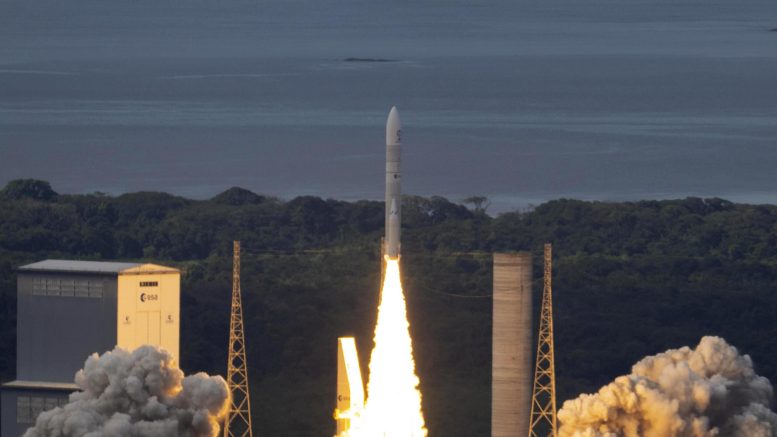
Ariane 6 launches on 9 July 2024 from Europe’s Spaceport in French Guiana. Credit: ESA – S. Corvaja
Ariane 6, Europe’s new heavy-lift rocket, completed its maiden flight from Europe’s Spaceport in French Guiana at 16:00 local time on 9 July (20:00 BST, 21:00 CEST).
Ariane 6 is the latest in the European Ariane series of rockets, succeeding Ariane 5, and featuring a modular and versatile design that can launch missions from low Earth orbit and further into deep space.
“It is rare for a completely new rocket to be launched, and its success is far from guaranteed. I was privileged to witness this historic moment when Europe’s next generation of the Ariane family successfully lifted off, restoring Europe’s access to space,” said Josef Aschbacher, ESA Director General.
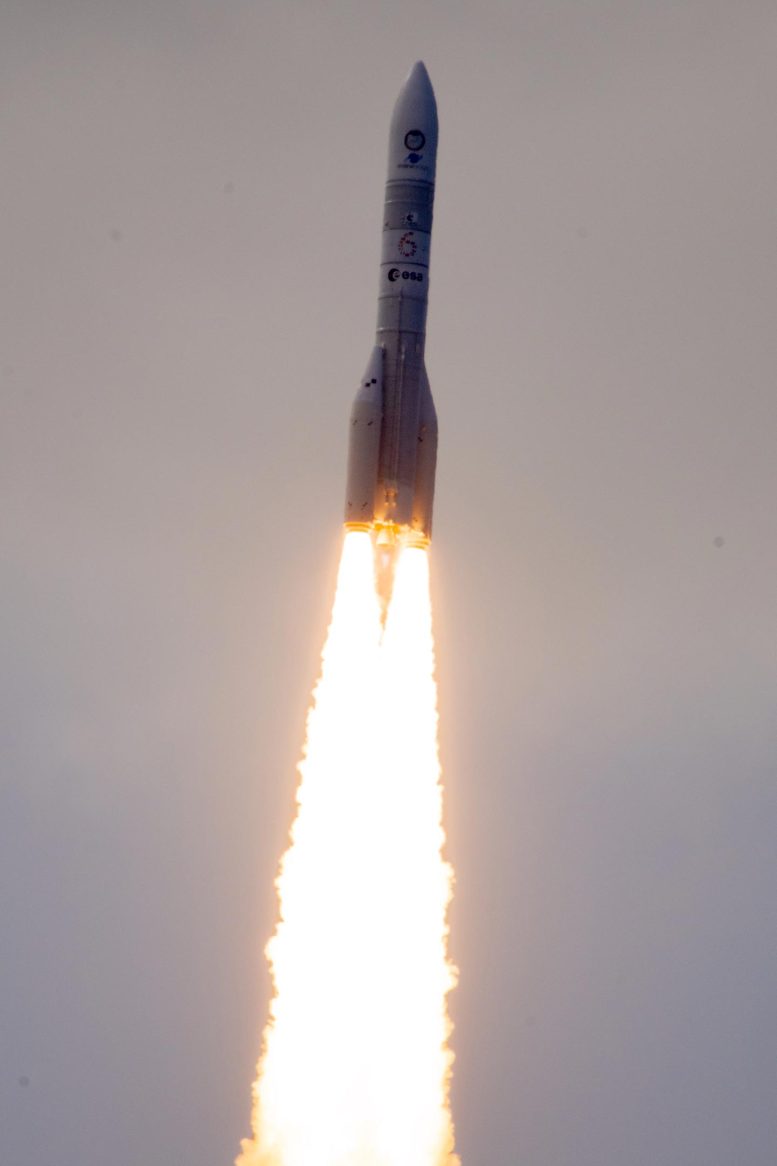
Ariane 6 launch on July 9, 2024. Credit: ESA – M. Pédoussaut
The triumph of European space innovation
“A maiden launch is a major undertaking, involving thousands of people who have worked tirelessly for years. The fact that the launch was a success on the first attempt is a testament to their dedication and to European excellence in engineering and technology. I warmly thank the teams at ESA, CNES, ArianeGroup and Arianespace for their hard work that has brought us to this point. I also want to sincerely thank our Member States for enabling and supporting the Ariane 6 programme throughout its journey. It is not always easy, but the endurance we have shown today has paid off handsomely.”
This inaugural flight, named VA262, is a demonstration flight whose objective is to demonstrate the capabilities and prowess of Ariane 6 to escape Earth’s gravity and move in space. It nevertheless had several passengers on board.
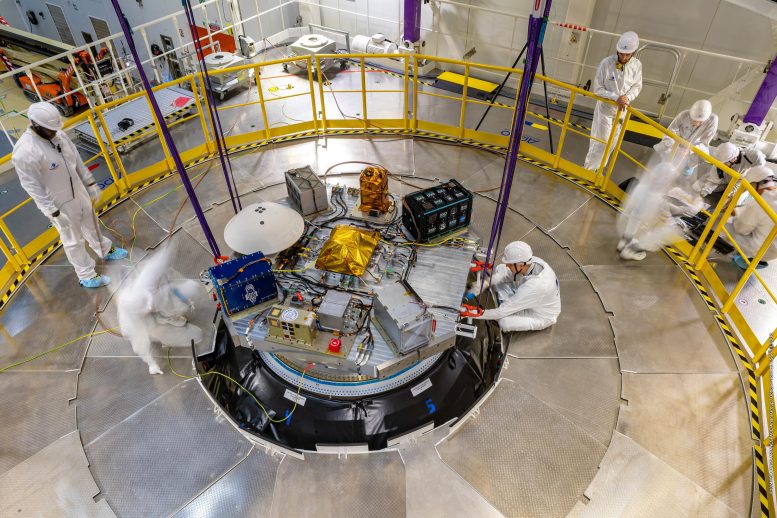
Ariane 6 payloads are installed in the encapsulation hall at Europe’s Spaceport in French Guiana on June 4, 2024. From big names like NASA to students designing their first satellites, these missions will measure gamma rays, track wildlife, test self-healing solar cells, confirm the theory of blackbody radiation, and more. There will be a smart agriculture satellite, a radio beacon demonstrator, experiments that will remain attached to the rocket’s payload “adapter,” and even capsules destined to re-enter Earth’s atmosphere to test new materials. Ariane 6’s maiden flight will be packed with technology as its first payloads are sent into space. Credit: ESA/ArianeGroup/Arianespace/CNES
Successful deployment and future prospects
At 21:06 BST, 22:06 CEST, one hour after liftoff, the first group of Ariane 6 satellites was released from the upper stage and placed in an orbit 600 km above the Earth. Satellites and experiments from various space agencies, companies, research institutes, universities and young professionals took part in this maiden flight.
In addition to the rocket, the liftoff demonstrated the operation of the launch pad and ground operations at Europe’s Spaceport. The new dedicated launch area, custom-built by CNES, is helping to speed up Ariane launches.
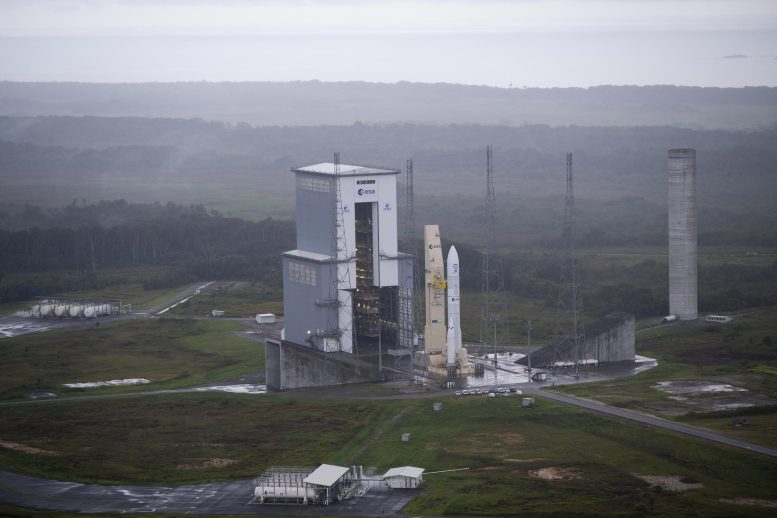
Ariane 6 seen from the sky a few hours before its first liftoff from Europe’s Spaceport in French Guiana. The 90-metre-high, 8,200-tonne mobile building is now in place and the tank filling is ready. Credit: ESA – S. Corvaja
A dynamic underway for Ariane 6
On the occasion of the launch, Philippe Baptiste, Director General of CNES, declared: “With this first successful launch of Ariane 6, Europe has finally regained its ability to access space. Beyond the great emotion I feel at this moment, my first thoughts go to all the teams in Kourou, Paris, Vernon, Les Mureaux, Toulouse, Bremen, Lampoldshausen, Liège, Barcelona, Colleferro, Zurich, and everywhere else in Europe who made this success possible. I would like to salute the commitment of the employees of CNES, ESA, ArianeGroup, Arianespace and our subcontractors. These last few months have been intense, and I would like to thank them all. Europe can be proud of its space programme, Europe can be proud of its know-how and expertise. Together, let’s prepare the future of launchers and space.”
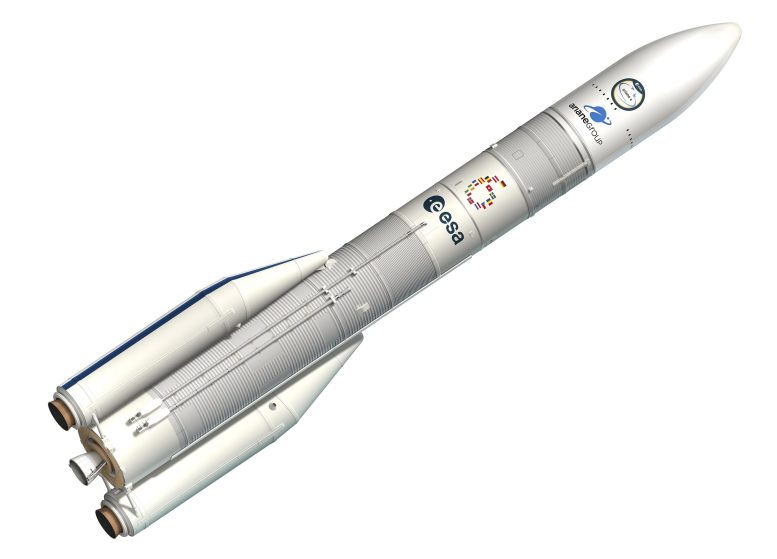
Artist’s impression of the European space transportation systems. Shown here is the twin-boom Ariane 6 (A62) launcher in Flight FM1 configuration, which will operate from Europe’s Spaceport in Kourou, French Guiana. Ariane 6 features a modular architecture using either two boosters (Ariane 62) or four boosters (Ariane 64), depending on the required performance. Credit: ESA – D. Ducros
Ariane 6 was built by ArianeGroup, prime contractor and designer. “With the success of Ariane 6’s first flight, the European space industry is entering a new era,” said Martin Sion, Chairman and CEO of ArianeGroup. “This historic launch demonstrates the unwavering commitment of our teams and partners, whom I would like to warmly thank for this success that reflects on the entire European industry. Seeing the new European launcher take off into space marks the culmination of an exceptional technical and technological adventure and the beginning of a long history of Ariane 6 operations. The next flight models are already in production and the stages of the second model will be shipped to the Guiana Space Center this fall for Ariane 6’s first commercial flight.”
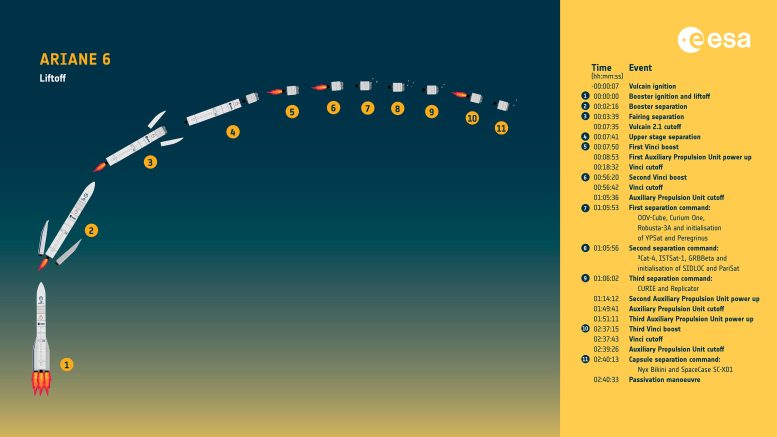
The first flight of Ariane 6 will take place in three phases, each of which will demonstrate the different capabilities of the launcher:
Phase 1 (events 1 to 5): from ground to orbit
The first phase of Ariane 6’s flight will consist of propelling the rocket from Earth into space using the thrust of the main stage powered by the Vulcain engine and the power of the two powerful P120C boosters. The first phase includes the separation of the main stage from the upper stage and the first pulse of the upper stage’s Vinci engine, which places the launcher and its passengers in an elliptical orbit 300 by 700 km above the Earth.
Phase 2 (events 6 to 9): re-ignition of the upper stage and deployment of the satellites
The next phase will be to test Ariane 6’s final feature: the relighting of the upper stage. Phase 2 will consist of relighting the Vinci engine, which will change Ariane 6’s orbit from elliptical to circular. This phase will be followed by the deployment of the rocket’s eight satellites and the activation of the five onboard experiments.
Phase 3 (events 9 to 12): technical demonstrations, deorbiting and capsule separation
The final phase of Ariane 6’s maiden flight will involve pushing the cryogenic upper stage to its limits and validating its ability to operate in microgravity. This final phase will initiate the controlled deorbit of the upper stage through the Earth’s atmosphere above the “NEMO point” in the South Pacific, to prevent it from becoming space debris. Moments later, the two reentry capsules on board will separate from the upper stage and the three modules will safely descend to their base.
Credit: ESA
Continue the journey
By placing satellites into orbit, Ariane 6 has demonstrated that it can successfully launch its payloads into space, but ground control has more to offer for its maiden flight. In the next hour, Ariane 6’s upper stage will once again demonstrate its ability to restart its Vinci engine using its new auxiliary thruster. This restart capability will allow Ariane 6 to deposit multiple passengers into different orbits on its next flights and to deorbit through the Earth’s atmosphere at the end of its mission, so as not to become space debris.
During this flight, the Ariane 6 upper stage is to release two re-entry capsules as it enters the Earth’s atmosphere for clean disposal and safe combustion, leaving no space debris in orbit.
The next Ariane 6 is scheduled to launch this year for its first commercial flight under the leadership of Arianespace, the launch operator and service provider. “The success of this first flight marks the beginning of Ariane 6’s operational career, providing Europe with autonomous access to space,” added Stéphane Israël, CEO of Arianespace. “The order book for the new launcher demonstrates Ariane 6’s versatility and its ability to perform a wide range of missions in multiple orbits. It reflects the trust that customers place in Ariane 6 for their institutional and commercial missions. We look forward to starting operations with our new launcher.”